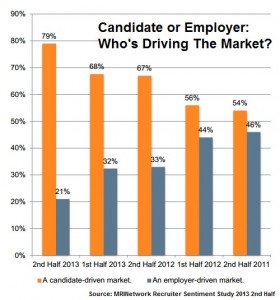 Over the past two years, recruiters in the executive and managerial space have observed significant changes in hiring practices, the most important being a shift from an employer-driven market to a candidate-driven market.
Over the past two years, recruiters in the executive and managerial space have observed significant changes in hiring practices, the most important being a shift from an employer-driven market to a candidate-driven market.
Following this trend, new data indicates the talent market is now overwhelmingly driven by top performers. Recruiters who responded to the most recent MRINetwork Recruiter Sentiment Study provide cautionary advice to employers who haven’t yet awakened to the new reality.
“I have been recruiting for nearly 11 years and I have never seen the market more candidate-driven than it is now. Candidates have choices and ‘A’ players are being heavily courted,” said a recruiter responding to the study.
According to the report, in the second half of 2013, 79% of recruiters described the labor market as candidate-driven, up 12 percentage points from a year ago.
The executive and managerial market continues to be so candidate-driven because the talent pool remains weak. As the economy rebounds, average candidates simply will not do – employers want star players to help them move their businesses forward. This leaves top performers at a strong advantage. Multiple job offers provide these candidates with more bargaining power and the ability to reject less desirable work agreements. According to the study, 42% of candidates refused job offers as a result of accepting an offer with another company, up from 33% in the first half of 2013.
MRINetwork recruiters report several reasons for why more jobs are being turned down:
- Qualified candidates are hard to find and also difficult to move. New jobs are not offering high enough salaries or enough benefits to incent a move.
- Top candidates are interviewing with multiple companies and have multiple offers to consider.
- Good candidates are becoming more difficult and demanding. Employers haven’t caught up yet. They still think they can get a great candidate cheap.
- Employers are taking too long to complete the interviewing process.
With rejected job offers on the rise, the candidate-driven market points to several things:
- Employer branding is more important than ever to entice star talent. “Companies should be re-visiting, from the top down, why their company is a great place to work, and why not,” said an MRINetwork recruiter.
- It is now crucial that employers find ways to streamline the hiring process to avoid losing their top picks. One recruiter noted, “Slow hiring processes give candidates access to more options and more time to rethink their reasons for making a change.”
- Salary and benefit packages need to be aggressive, not simply market-competitive. Another recruiter added, “More employers need to consider offering a higher salary if their benefits are not as competitive with those currently provided to the candidate. Many employers looking to hire have cut back on benefits and this isn’t being covered by increased salaries.”
- Counteroffers are a reality, especially when it comes to top performers. Since exceptional candidates are frequently recruited from other companies, prospective employers should be prepared to offer a salary and benefits package that the current employer is not likely to beat.
The good news is that more employers are realizing the executive and managerial market is candidate-driven. According to the study, almost 25% of employers are presenting job offers within two weeks of the first interview, up about 6 points from the first half of 2013.
While the study results demonstrate that hiring trends are highly favorable towards top performers in the executive and managerial space, the data is not representative of overall hiring. The Federal Reserve noted in its most recent Beige Book, that hiring is showing “a modest increase or was unchanged… Difficulty with finding qualified workers, especially for high-skilled positions, was frequently reported.”
Even still the survey results are encouraging, showing consistent signs of economic recovery.